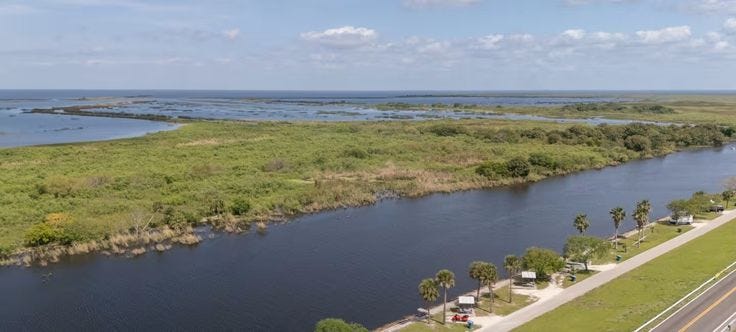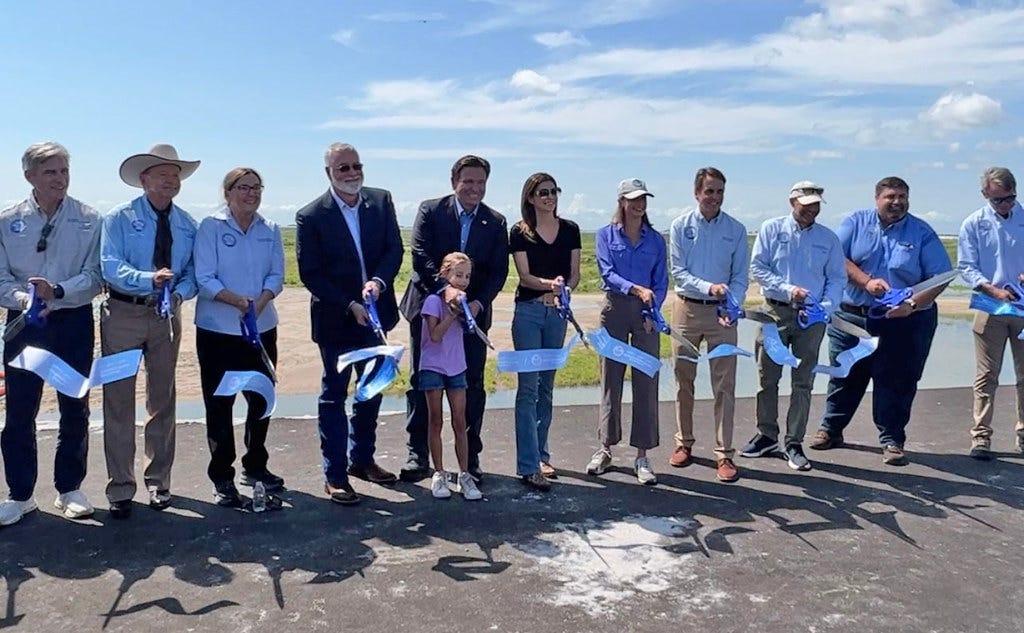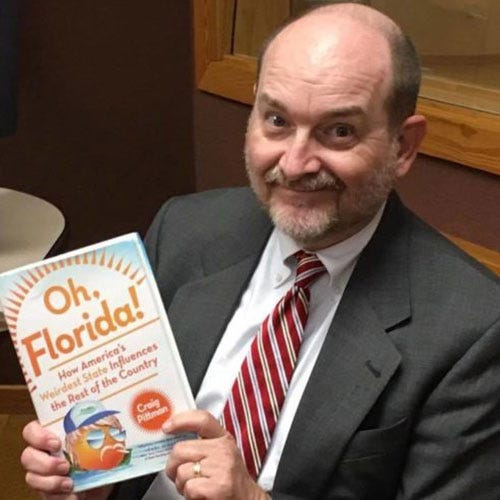Big Florida lake ranked the most polluted in the United States
Lake Okeechobee's problems have been building for years, and state officials show no interest in fixing them

Editor’s Note: The following article by acclaimed reporter Craig Pittman originally was published in the Florida Phoenix and is shared today in Tropic Press with permission of the Tallahassee-based nonprofit news site.
By Craig Pittman
Florida Phoenix
I am such a big booster of Florida and its features! I am constantly telling people about the many ways in which we beat the rest of the nation.
We have the best state park system, one that’s won national awards four times! Our beaches are often ranked the best in the country! And I recently heard that we have the most polluted lake in the nation!
Wait. That one’s not so great, is it?
“Lake Okeechobee is known as the largest freshwater lake in the state of Florida, but a new study also ranks it as the dirtiest lake in the country,” WPBF-TV reported last month.
The finding came from an unlikely source: a website called “Lake.com,” which promotes vacation rentals on or near the water.
But these folks did their homework. They evaluated the 100 largest lakes in the nation using chemical data from the Environmental Protection Agency’s National Water Quality Monitoring Council from January 2020 to July 2025.
Lake O, often called “the liquid heart of Florida,” had high levels of lead contamination, turbidity, and elevated phosphorus levels — “a combination that contributes to murky appearance and potentially stimulates algae growth.”
Sounds like our liquid heart is having some serious heart trouble, doesn’t it?
The South Florida Water Management District, which shares responsibility for operating Lake O (more on that in a minute), contended to WPBF that the figures used in the survey were misleading.
At first, I was willing to give the agency known as “Softmud” the benefit of the doubt. This wouldn’t be the first time some random website conjured up a controversial listicle just to make people argue about it, coming up with clickbait like “The Five Most Frightening Stephen King Books and Four That Totally Suck.”
But when I checked this out with those in the know, they told me the bad rating was dead-on.
“It’s not surprising to me or to anyone else that this ranks as the worst lake in North America,” said Gary Roderick, former southeast bureau chief for the Florida Department of Environmental Protection.
The lake’s water quality has undergone such a long, slow slide, several people told me, that some folks may not have noticed how awful it’s become.
But the lake has earned its place at No. 1.
“It is no surprise that Lake Okeechobee has been named the dirtiest lake in the nation,’ a disgrace that could have been averted as the writing has been on the wall for many decades,” former SFWMD member Jacqui Thurlow-Lippisch told me.
She and Eve Samples of Friends of the Everglades both pointed a finger at the state’s failure to protect the lake from well-connected polluters.
“Without teeth in our cleanup laws,” Samples said, “this ‘dirtiest lake”’ designation is something we’ll have to put up with until we finally get Lake Okeechobee cleaned up.”
A slow-motion cyclone
Lake Okeechobee means “big water” in the Seminole language. The water district calls that “an appropriate name for a water body whose opposite shore can’t be seen from the water’s edge.”
At 730 square miles, it is the largest lake in the southeastern U.S. and the second largest in the nation located within a single state. But it’s fairly shallow, with an average depth of just 9 feet.
Yet that shallow water has been deadlier than any Stephen King villain. In 1928 a hurricane hit South Florida and turned Okeechobee into what Florida novelist Zora Neale Hurston called a “monstropolous beast” that walked the earth “with a heavy heel.” Hundreds or possibly thousands of people living by the lake drowned.
The U.S. Army Corps of Engineers built an earthen dike named for Herbert Hoover around the lake to prevent that from happening again.
The same agency straightened out all the bends in the Kissimmee River, ending its seasonal flooding of pastures and farm fields.
As a result, the gentle river flowing into the lake became a ditch that funneled pollution straight into it. (The Corps, to its credit, has more recently put the bends back.)
Meanwhile, the dike and a new road called the Tamiami Trail blocked water from its normal path south into the Everglades. Instead, Lake Okeechobee — jointly run by the Corps and the water district — began functioning as both a water supply source for the towns and a disposal basin for the sugar companies flushing excess fertilizers from their fields.
As an added contaminant, state agencies have routinely dosed aquatic plants on the lake with powerful herbicides. Think of it as flavoring!
Don’t get me wrong. The lake has long been a wonderful place for seeing wildlife. One of the greatest mornings of my life came the day when I saw roughly 1,000 migrating swallowtail kites lifting off from some pines at the lake’s edge, circling like a slow-motion cyclone.
Hiking and bicycling fans love the 110-mile Lake Okeechobee Scenic Trail — LOST for short — which circles “the Big O” atop the 35-foot dike. And bass anglers have long bragged about their take from the lake.
But the state of Lake O has gotten worse and worse because of the rampant pollution, and even the wildlife began showing the effects.
As Newton Earl Cook from United Waterfowlers of Florida pointed out last week in an op-ed in the Palm Beach Post: “The situation seemed dire two years ago when Bass Masters removed Lake Okeechobee from its Top Ten Bass Lakes in the United States.”
Algae season
The problems of Lake Okeechobee go beyond the lake. That’s because of the life-saving dike.
If the water in the lake gets too high, the ancient embankment could crack. Water could pour out, drowning the towns nearby like it’s 1928 all over again.
When the water level approaches a possible breach, the Corps flushes a lot of the water out. They dump it into a pair of waterways that send it shooting out to Fort Myers on one side of the state and Stuart on the other.
Nothing good happens when they do that. And it keeps on happening.
“Toxic algae bloom crisis hits Florida, drives away tourists,” was the headline on a story I wrote in 2016. The Corps’ release of water from the lake had spread its toxic blooms to both coasts, ruining the tourist economy of both.
“This economic and environmental disaster was cooked up in the stew pot that is Lake Okeechobee, where state officials have not required pollution limits to be met since those limits were created in 2001,” I wrote nine years ago.
This repulsive mess got even worse in 2018. Toxic algae blooms had become so widespread that it became known as “the Summer of Slime.”
Rick Scott, then the governor, was running for the U.S. Senate. People who blamed him for allowing the increased pollution fueling the algae blooms booed him so thoroughly at one campaign appearance that he fled. For years afterward, he’s been known as “Red Tide Rick.”
This was the year an obscure congressman named Ron DeSantis first ran for governor. He vowed to fix the algae bloom problem. After he took office, he appointed a panel of actual scientists to recommend ways to get rid of the algae blooms. They did.
Then he and the Legislature ignored nearly all of their recommendations,
Instead, they passed the irresponsible but ironically named “Clean Waterways Act,” full of voluntary measures, not mandatory ones.
Imagine if we used a similar approach to homicide.
“Murder is definitely NOT okay, people,” we’d tell everyone. “Not cool! Please don’t do it! But if you slip up and blow someone away, hey, don’t worry. Nobody will punish you for it.”
Considering how much these toxic algae blooms affect people’s health, that’s pretty much what’s happening with our lack of limits on pollution.
Guess what’s happening in Lake O right now. “Florida Department of Health issues blue-green algae alert for Lake Okeechobee,” WPBF-TV reported last week.
“This is algae season in Florida,” Friends of the Everglades’ Samples said. “That’s now an annual problem.”
Just like the Blob
The good news is that, so far in 2025, we haven’t experienced any hurricanes dumping big buckets of rain on Florida.
As a result, the Corps hasn’t needed to drain Lake Okeechobee to the coasts, which means those areas have been spared any toxic algae blooms.
But when it comes to cleaning up the lake itself, well, the good news is in short supply.
“Primarily agriculture and developments’ brazen, dominant monetary influence on generations of most state politicians has gotten us here,” Thurlow-Lippisch of the water management district told me.
Instead of clamping down on polluters, the DEP has set up a series of “basin management action plans” that just plain don’t work.
“Rainfall runoff that flows into Lake O from hundreds of surrounding properties routinely exceeds the [pollution] limit — without the state imposing any consequences,” TCPalm.com reported in 2022. “All 32 drainage basins around the lake with available data exceeded the limit over a five-year average.”
The continuing degradation of the lake is “a reflection of the flawed BMAP [Basin Management Action Plan] process,” Samples told me.
What would help the lake is if the state were to pay ranchers and other landowners north of the lake to restore the complex chain of wetlands that once filtered out pollution, said Julie Wraithmell, executive director of Audubon Florida.
Ideally, she said, the southward flow through the wetlands toward the lake would proceed like playing a giant version of the plinko board on “The Price Is Right.” By the time the water reaches its destination, it will have been cleaned naturally.
“The Everglades is not going to be fully restored until we fully restore Lake Okeechobee to its former glory,” Wraithmell said.
Instead of turning to natural cleanup methods, the government has turned to artificial means.
The latest component of the $20 billion Everglades rescue, into which the state and feds have invested millions of tax dollars, is a 10,000-acre reservoir called the C-43 that just opened this summer, said Joe Cavanaugh of the Calusa Waterkeeper.
The reservoir is supposed to hold excess runoff as well as water released from the lake, so it won’t have to go straight to the estuaries near Fort Myers.
But that still doesn’t solve the lake’s continuing problem with what Cavanaugh called “the legacy pollution” that flowed into it unchecked for decades, fueling those algae blooms.
But fear not, my fellow Floridians! I have a plan for dealing with that.
The Legislature has begun holding committee meetings to discuss the priorities for the next session. We’re also nearing the popular Halloween holiday.
Those two events make this the perfect time to strike.
Everyone who’s tired of seeing Lake O being turned into a toilet, let’s all gather along the dike in the dead of night on All Hallows’ Eve. We can all join hands and chant an ancient incantation.
Then, slowly, ever so slowly, a new monstropolous beast will rise up — a toxic green mass of algae full of malevolent energy, like “The Blob” from the 1950s.
We will point it toward Tallahassee and tell it, “Go get’ em!
Craig Pittman is a native Floridian. In 30 years at the Tampa Bay Times, he won numerous state and national awards for his environmental reporting. He is the author of six books. In 2020 the Florida Heritage Book Festival named him a Florida Literary Legend. Craig is co-host of the “Welcome to Florida” podcast. He lives in St. Petersburg with his wife and children.
Florida Phoenix is part of States Newsroom, the nation’s largest state-focused nonprofit news organization.
A few years ago, I spent two weeks driving around Florida, from Key West to Pensacola — and dozens of points in between — researching odd destinations for my novel Florida Man, the second book in The Strange Files series. All during this long, meandering road trip, I listened to and was informed by Craig Pittman’s Oh, Florida! I’m delighted to share some of Craig’s work here today on Tropic Press, and I want to take this opportunity to thank him for helping make that journey through the Gunshine State such a pleasure.
— J.C. Bruce, editor, Tropic Press
Today is …
Oct. 12 is the actual day in 1492 that indigenous Americans discovered a lost Italian named Columbus wandering around their beach. They could have run him off, but instead brought him gifts. Further proof there is no such thing as a small decision.
Quote for the day
“The earth, the air, the land, and the water are not an inheritance from our forefathers but on loan from our children. So we have to hand over to them at least as it was handed over to us.”
— Mahatma Gandhi
Florida factual
Lake Okeechobee is the second-largest natural freshwater lake contained entirely within the contiguous 48 states. It covers 730 square miles and is exceptionally shallow with an average depth of only nine feet. Bull sharks, which can live in both freshwater and saltwater, inhabit the lake along with alligators, so good luck if you fall overboard.
More online
Thank you for reading the Tropic Press newsletter. You also have access to the Tropic Press website for additional and previous posts, copies of the Monthly Memo, an archive of posts from our advice columnist, Miss Mingo, occasional guest commentaries such as today’s by Craig Pittman, and information about The Strange Files series of mysterious adventures and other books.
J.C. Bruce, journalist and author, is the founder of Tropic Press. He holds dual citizenship in the United States of America and his native Florida. Forward this email to your friends. They will love you for it.
Thanks to our sponsor
Today’s report is brought to you by Tropic Press Books, home of The Strange Files. Interested in sponsoring these reports? Contact: Advertising@Tropic.Press
It’s good to share
Tropic Press is a reader-supported publication. Here’s a big shout-out to all our loyal subscribers. Feel free to forward this email to your friends so they can enjoy it too. The more people we reach, the greater community of like-minded people we build. This is your chance to be part of all that. Thank you.














I'm 73 and I used to camp on fisheating creek back in the early 70's. I never went on Lake Okeechobee. I was talking to a neighbor that told me in the late 70's he would go snorkeling there and that the water was so clear that you could see huge bass down in 10 to 12 ft. of water.
Why would I read your article, if you can’t spell the word Polluted in your headline. I thought it was a type-o, but you misspelled it several times